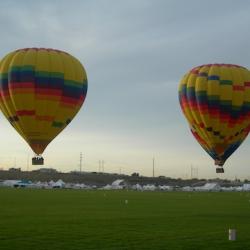Source Institutions
Source Institutions
Add to list Go to activity
Activity link broken? See if it's at the internet archive

In this quick activity (located on page 2 of the PDF under GPS: Balloon Fiesta Activity), learners will see the effects of convection and understand what makes hot air balloons rise. Learners will fill a bottle with hot water colored red and another bottle with cold water colored blue, then lower both into a container of water and observe the interaction of liquids of different temperatures/densities. Relates to the linked video, DragonflyTV GPS: Balloon Fiesta.
- 5 to 10 minutes
- 10 to 30 minutes
- 1 cent - $1 per group of students
- Ages 8 - 14
- Activity, Demonstration, Experiment/Lab Activity, Lesson/Lesson Plan
- English
Quick Guide
Materials List (per group of students)
- a clear tank or large pitcher
- 2 small glass bottles with narrow mouths
- string and scissors
- tap water, hot water, ice water, and ice
- red and blue food coloring
Subjects
-
Earth and Space Science
-
Earth Structure
- Atmosphere
-
Earth Structure
-
Engineering and Technology
-
Engineering
- Transportation Engineering
-
Technology
- Transportation
-
Engineering
-
Physical Sciences
-
Heat and Thermodynamics
- Heat and Temperature
-
Motion and Forces
- Gravity
-
States of Matter
- Liquids
-
Structure and Properties of Matter
- Volume and Density
-
Heat and Thermodynamics
-
The Nature of Science
-
The Scientific Process
- Conducting Investigations
- Formulating Explanations
-
The Scientific Process
Informal Categories
- Transportation
Audience
To use this activity, learners need to:
- see
- see color
- touch
Learning styles supported:
- Involves hands-on or lab activities
Other
Components that are part of this resource:
This resource is part of:
Access Rights:
- Free access
By:
Source Collection
- DragonflyTV
Rights:
- All rights reserved, Twin Cities Public Television, Inc., 2007
Funding Source:
- National Science Foundation, 610429
